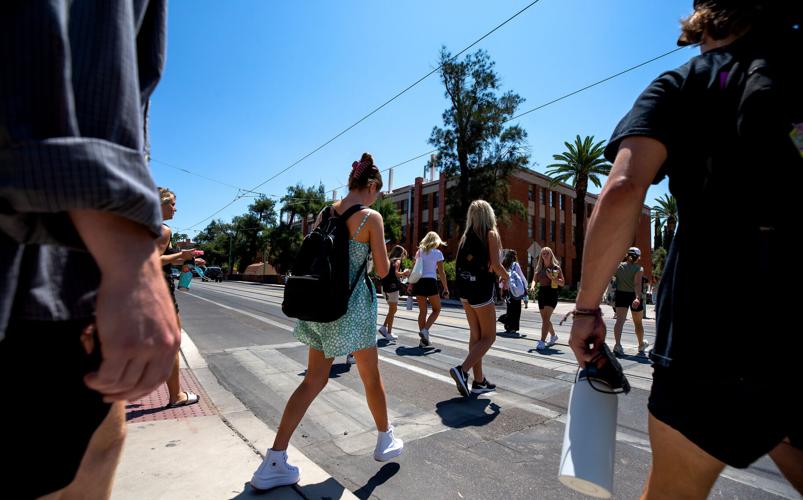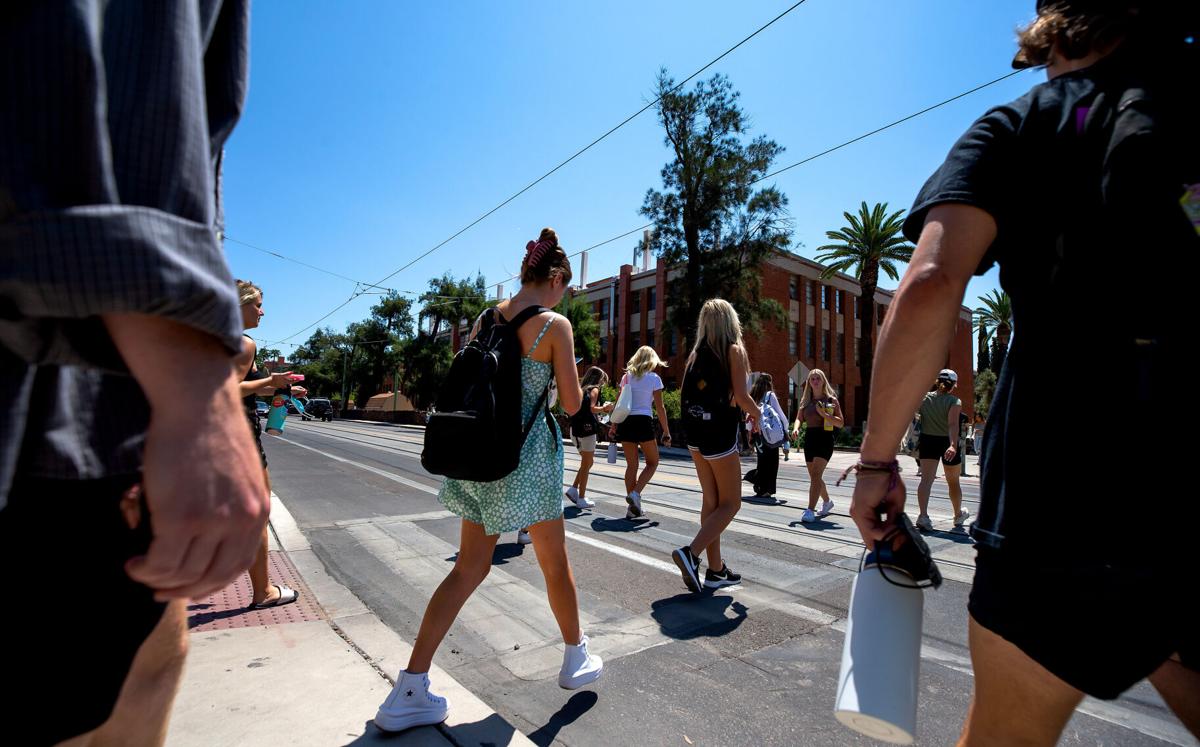It’s a new year and a new semester at the University of Arizona. January 2022 also happens to mark another inflection point in the COVID-19 pandemic — the omicron variant.
The highly contagious but seemingly less severe variant was first detected at the UA about a week after most students and staff left for holiday break last month and it’s driven Tucson’s recent spike in cases.
As colleges and universities across the country prepare to start the spring semester, omicron has surfaced as the latest obstacle for institutions trying to deliver high-quality education amid an ongoing public health crisis.
Arizona’s flagship university, which has more than 47,000 students and 16,000 employees, is no exception.
Numerous big public universities, including Michigan State University, UCLA and the University of Illinois at Urbana-Champaign, have already announced plans to start this semester in a remote setting. Despite calls from the United Campus Workers Arizona, the union representing UA faculty and staff, for the UA to do the same, the UA has not budged on its plans to reopen at full capacity on Wednesday.
Now, the question on some UA worker’s minds is if the other precautions the UA has put in place to accommodate in-person learning — including a surgical-grade mask mandate, an employee vaccine mandate, required testing for students who live on campus and strong suggestions that all other students and staffers take regular COVID-19 tests — will provide both adequate community protection against the omicron variant and the learning experience students expect.
If the past is prologue, some fear those precautions may not be enough.
Learning pauses
Last fall, the UA reopened at full capacity for the first time since the pandemic began in March 2020. At the start of last semester, the delta variant — which typically causes more severe symptoms than omicron — had some faculty, staffers and students concerned about returning for face-to-face instruction.
Nonetheless, the UA moved forward with its reopening plans, just as it is this semester.
“We want students to learn, we want them to be safe, but we also want them to be supported,” said Emma Gomez, a career-track faculty member in the English department and member of the union.
Gomez recalls that last semester, as the delta variant surged, a lack of flexible teaching conditions created learning disruptions for her students who had to quarantine. She noticed that others were chronically absent. A few dropped out altogether. And many told her that just sitting in big classrooms with no certainty that their peers were vaccinated was enough to amplify pandemic-induced anxiety.
“As much as we try to move forward and go with business as usual, you can’t. It’s a lot of pauses and stopping that keep happening. If it happened in the fall, at this rate, I can see it happening more regularly,” she said “How is that going to be productive in terms of teaching?”
The UA’s unwillingness to start the semester remotely also makes her wonder, “Are we putting dollars first or student and employee well-being first?”
The UA did not respond to the Arizona Daily Star’s questions about its reasoning for starting the school year in person despite growing concerns about the omicron variant.
In terms of actually containing the virus, Dr. Joe Gerald, an associate professor of public health policy and management at the UA, said that last semester, the university itself was able to keep case counts “relatively low” through its campus-level mitigation efforts.

University of Arizona President Robert Robbins, in red at right, sits amid unmasked fans at McKale Center.
Changed dynamic
“What was going on in the broader community was more problematic,” Gerald said of the delta variant’s weight on Arizona and Pima County’s medical systems last fall. But because about half of all omicron cases are present in patients between the ages of 20-40 — in part due to lower vaccination rates among that age group — it “really changes that dynamic.”
According to the most recent data available, more than 84.5% of UA employees, including student-workers, are vaccinated, and 62% of students have voluntarily shared their vaccination status with the university.
Those numbers account only for students and employees who have received the first two doses of the vaccine. Without a third booster shot, the vaccine appears to be less effective at protecting people from the omicron variant.
In addition to asking for a remote start to the semester, the union has also called for a student vaccine mandate with appropriate exemptions. Although Gov. Doug Ducey signed an executive order last summer barring any such mandate at public colleges and universities, a court voided it last fall, which means it would be legally permissible for the UA to require student COVID-19 vaccines.
Nonetheless, the governor and his allies in the Legislature have remained vocally opposed to vaccine mandates. And the UA, which is governed by the Arizona Board of Regents whose members are appointed by the governor, did not respond to questions from the Star about its intent to require a student vaccine mandate.
‘Inaction’ brings consequences
In Gerald’s view, however, the time for a student vaccine mandate to protect against omicron has passed. Omicron is here, and like most public health experts, he’s expecting the worst of it to play out later this month.
“It’s not like our world is coming to an end and we’re all going to die, but there are going to be preventable deaths,” he said, noting that clogging up emergency rooms and urgent care centers even with mild COVID-19 cases will make it more difficult for people experiencing a medical crisis like a heart attack or stroke to get immediate care. “The time to act (on student vaccine mandates) was November or December. Now, we’re just trying to manage the consequences of our inaction.”
Starting off the semester remotely, however, is one way to do that.
“Bringing students back in this environment is just going to exacerbate and contribute to transmission that’s already raging in our community,” Gerald said, likening omicron to a short-lived summer thunderstorm. “We know it’s there, we know we can avoid it, so why try to fly through it?”






